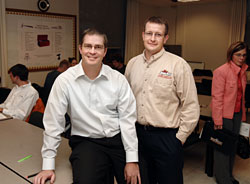Inside Iowa State
Inside ArchivesSubmit newsSend news for Inside to inside@iastate.edu, or call (515) 294-7065. See publication dates, deadlines. About InsideInside Iowa State, a newspaper for faculty and staff, is published by the Office of University Relations. |
Nov. 3, 2006 
Chuck Steiner (left) and Mike Retallick Science With Practice moves beyond pilot phaseby Barbara McBreen, Ag Communications Studying bacterial diseases in rice. Restoring a prairie. Writing guidelines on how to manage an insect zoo. Using hydroponics to grow basil. Testing mosquito detection algorithms. These are just a few projects undergraduate students have pursued in "Science With Practice." It's a program within the College of Agriculture that allows students to earn course credit, get paid for the work they do with a faculty or staff mentor and pursue their major area of interest. The task of writing a curriculum that could fit the individual needs of students and faculty working in 15 departments and 25 majors went to Mike Retallick and Chuck Steiner, assistant professors in the agricultural education and studies department. "The challenge was to take all of these activities and develop a program that met individual needs," Retallick said. "The centerpiece is the learning agreement, which is negotiated between the student and the faculty or staff mentor." Students are required to do a learning agreement for each semester they enroll in the program. Pilot experienceThe pilot program began in the spring of 2005, with funding from the College of Agriculture and the Iowa State University Agricultural Endowment, which provides scholarships, grants and other support for research and educational activities. "The idea was to find a way to help undergraduate students get better connected to research and educational programs," Steiner said. "We also wanted students to grasp the research, which is a focus of the program." The challenge was to find a tool to help students with college expenses and help faculty maximize their grant opportunities. Mark Honeyman, professor of animal science, initiated the idea of providing a meaningful on-campus, paid internship for students. "It's an opportunity for both students and faculty," Honeyman said. "Students are given more responsibility in projects that help them learn, while they earn credits, get paid and gain practical experience." Theory and experienceThe mission fit both Steiner and Retallick's interest in experiential learning theory, which focuses on helping students learn from practical work experiences. The curriculum requires each student to maintain a journal and prepare a portfolio, presentation and final report. "It's taking the learning experience and letting students reflect and evaluate what they have accomplished," Steiner said. "We often hear students ask why they need to take certain courses. Now, they can tie the course directly to the research or project they are working on. The students get experience and faculty get students who are engaged and understand the research." Pilot concludedThis fall is the first semester the program has not been a pilot program. Since its start, 83 students and 79 faculty and staff mentors have participated in the program. Today, students can be found across campus working at research farms, greenhouses, offices, labs, centers and other units. Students and faculty who participated in the first semester of the project were asked about the benefits and limitations of the program. Both faculty and students said it improved students' listening, time management, communication, organizational and research skills. "The collaboration and communications between faculty and students increased," Retallick said. "Students are willing to take on more responsibilities and faculty are more willing to give students those responsibilities." One-third of the students surveyed said there were unexpected benefits. The program increased networking opportunities, graduate research preparation and career options. Kelly Norris, a sophomore in horticulture, is in his second semester of the program. He is analyzing the genetic material of hostas, a popular ornamental perennial plant, to provide an informational database for nursery use. He said the experience has provided a foundation for his graduate work in plant genetics because the molecular techniques he's using are increasingly important. "It's a great opportunity," Norris said. "It provides a great structure for learning. Being required to reflect on your experiences strengthens the mental relationship between actual application and the concepts behind it." Attracting faculty also was a challenge in developing the curriculum. Retallick said faculty members already are under time and resource constraints, so they wanted a program that was simple to implement. The Agricultural Endowment Board also provided matching funds for student wages, which provided an incentive. "It encourages people to participate," Steiner said. "Our research shows the benefits, but you still have to sell the faculty members first." |
SummaryThe Science With Practice program in the College of Agriculture allows students to work within their major areas of interest while they earn credits and get paid. Quote"It's an opportunity for both students and faculty. Students are given more responsibility in projects that help them learn, while they earn credits, get paid and gain practical experience." Mark Honeyman, professor of animal science |